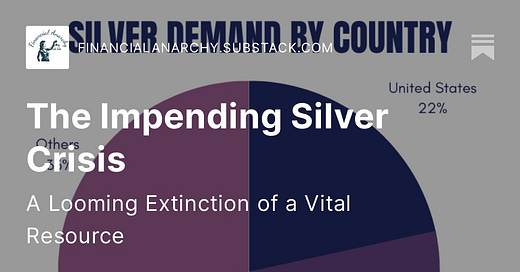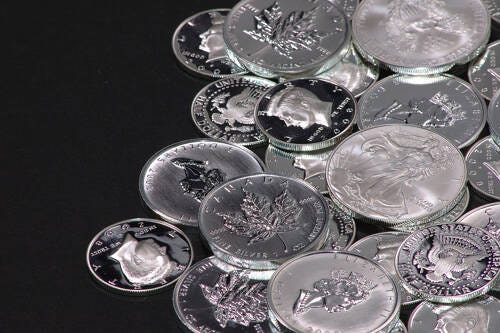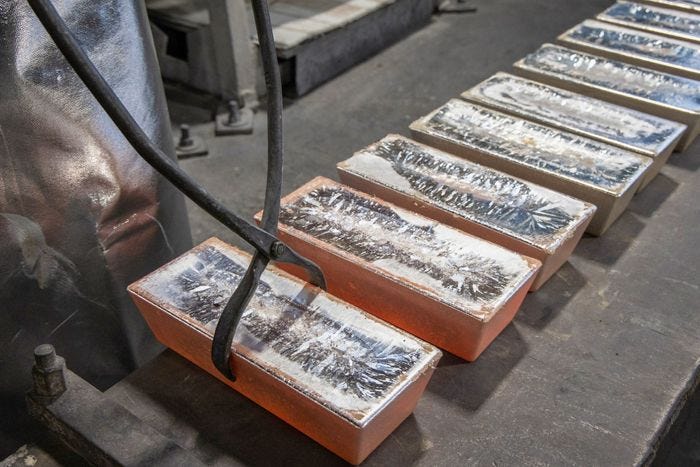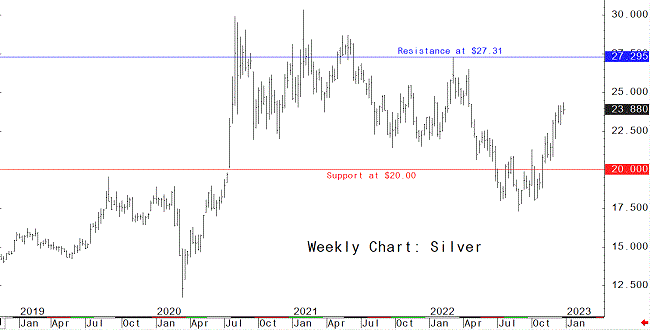Welcome to this captivating analysis of a YouTube video by Maneco64, where we delve into a crucial matter that has the power to reshape global markets and profoundly influence various industries.
In this edition, we focus on the possibility of a significant silver shortage and its potential consequences for the world economy. Our exploration is centered around the research and insights provided by a prominent analyst named Xiao Jun, who argues that if current trends persist, silver could become extinct within a few decades.
Section 1: The Extinction Threat
1.1 Silver Demand and Production Disparity
Xiao Jun highlights the disparity between China's substantial silver demand and its limited domestic production. This section examines China's reliance on silver imports and the potential consequences of its dwindling reserves.
According to the analysis presented, we may be on the verge of witnessing one of the most substantial bull markets in history, specifically in the realm of silver. This situation is particularly concerning as no other natural resource has ever gone extinct. However, the depletion of silver reserves could become a reality for major silver-producing countries, with China being a focal point.
China, being one of the largest silver consumers globally, heavily relies on silver imports due to its limited domestic production capacity. Alarming projections suggest that China's silver resources may be exhausted by 2032 if the current mining rate continues. Once China's reserves are depleted, the country will heavily depend on imports, leading to adverse effects on the global supply-demand dynamics. The potential scarcity of silver is especially worrisome considering its crucial role in the development of new technologies, particularly in the field of alternative energy sources such as photovoltaics and solar panels.
1.2 Global Silver Supply and Demand
This section delves deeper into the dynamics of global silver supply and demand, examining the current state of silver production and consumption worldwide. It highlights the impending depletion of silver resources in major producing countries and the potential consequences for global supply.
The analysis begins by addressing the situation in Mexico, the world's largest silver producer. Projections suggest that Mexico's silver reserves are expected to be exhausted by the end of 2026. This looming depletion of silver resources in a significant producer raises concerns about the overall global supply of silver. Mexico's case serves as a prominent example of how the depletion of reserves in major producing countries could have far-reaching implications for the global silver market.
The article then expands the scope beyond Mexico, emphasizing that other leading silver-producing nations are also facing challenges in maintaining their silver reserves. As demand for silver continues to grow across various industries, including electronics, solar energy, and medical applications, the strain on global silver supply becomes increasingly apparent. The limited production capacity in other nations further exacerbates the potential supply shortfall.
It also highlights the growing demand for silver, particularly in high-tech industries. The article mentions China's ambitious plans for technological development, which heavily rely on silver as a critical component. China's increasing demand for silver, coupled with limited domestic production, necessitates significant silver imports to meet its industrial needs. This reliance on imports underscores the vulnerability of the global supply chain and the potential consequences of a silver shortage.
The imbalance between global silver supply and demand is a cause for concern. As the article explains, if the current trend persists, the annual supply of silver is projected to fall significantly short of demand. This widening gap between supply and demand not only poses challenges for industries relying on silver but also has broader economic implications. It can lead to increased prices, market volatility, and potential disruptions to supply chains across multiple sectors.
The article emphasizes the importance of addressing the global silver supply and demand imbalance. It calls for proactive measures to mitigate the potential crisis, such as promoting responsible mining practices, investing in silver exploration and extraction technologies, and diversifying sources of silver supply. Additionally, it underscores the need for greater efficiency in silver usage and encourages the development and adoption of alternative materials in industries where silver is not irreplaceable.
Section 2: Geopolitical Tensions and Negotiations
2.1 Geopolitical Implications
The potential geopolitical implications of the silver crisis are explored in this section, shedding light on the behind-the-scenes negotiations that may be taking place between the United States and China. As the two largest economies in the world, any discussions regarding the scarcity of silver and its impact on the global economy can have far-reaching consequences.
The silver crisis raises concerns about the geopolitical landscape, as countries compete for limited resources and seek to secure their access to silver reserves. The negotiations between the United States and China, as suggested by Xiao Jun, indicate the recognition of the gravity of the situation and the need for collaborative solutions.
Geopolitical tensions may arise from the competition for silver resources, particularly considering the vital role silver plays in various industries and technologies. The increasing demand for silver, coupled with the limited availability, could lead to heightened competition and potential conflicts over access to this precious resource.
These negotiations between the United States and China reflect the recognition of the potential economic and strategic implications of the impending scarcity of silver. The outcome of these discussions could have profound implications for the global silver market, as well as for the economies and industries reliant on this essential resource.
Furthermore, the geopolitical implications extend beyond the United States and China, as other countries with significant silver reserves may also be involved in diplomatic discussions to address the silver crisis. The scarcity of silver has the potential to disrupt global supply chains, influence trade relationships, and reshape alliances.
Section 3: Industrial Significance of Silver
3.1 Silver's Role in Technological Advancements
The crucial role of silver in driving technological advancements and its significance in various industrial applications. Silver possesses unique properties that make it indispensable in several high-tech industries and emerging technologies.
Silver availability is of paramount importance for industrial use, especially in sectors that heavily rely on technological innovation. China, with its ambitious plans for technological development until 2035, recognizes the critical role of silver as a fundamental component in achieving its goals. Silver is used in a wide range of industries, including electronics, telecommunications, automotive, aerospace, and renewable energy.
In the field of electronics, silver is a key component in the production of conductive materials and connectors. Its excellent electrical conductivity and corrosion resistance make it an ideal choice for manufacturing high-performance electronic devices, such as smartphones, tablets, and computers. The demand for these devices continues to rise, leading to increased silver consumption.
Moreover, silver is extensively used in the telecommunications industry for the production of antennas, connectors, and other components essential for wireless communication systems. The increasing global demand for faster and more reliable telecommunications networks puts additional strain on the availability of silver.
In the automotive sector, silver is utilized in various applications, including electrical systems, sensors, and catalytic converters. As the automotive industry moves toward electric vehicles and advanced driver-assistance systems, the demand for silver is expected to grow significantly.
Silver's importance is also evident in the aerospace industry, where it is used in electrical contacts, bearings, and coatings. The exceptional conductivity and thermal properties of silver make it crucial for the reliable operation of aerospace equipment and systems.
Additionally, silver plays a pivotal role in the development of renewable energy technologies. Silver-coated solar panels and photovoltaic cells are widely used in solar energy generation, contributing to the global shift toward sustainable and clean energy sources. With the increasing focus on renewable energy, the demand for silver in this sector is projected to rise substantially.
The potential depletion of silver reserves, as highlighted by the author, poses significant challenges to the advancement of civilization. If silver becomes scarce, it could impede the development and adoption of new technologies, hindering progress in various industries. This could have far-reaching consequences for economic growth, energy transition, and sustainable development.
Section 4: Timetable of Resource Depletion
4.1 The Journey to Extinction
Xiao Jun presents a detailed timeline for the depletion of silver resources in major producing countries. The information is based on data released by the U.S. Geological Survey (USGS), which provides valuable insights into the current state and projected future of silver reserves.
Xiao Jun's analysis takes into account various factors such as the current mining rate, known reserves, and estimated consumption patterns. By combining this information, a timeline for the journey towards silver resource depletion is constructed, shedding light on the potential future scenarios.
The timeline begins with the current state of silver reserves and their respective production rates in major producing countries. It factors in the ongoing demand for silver, taking into consideration its diverse applications across industries such as electronics, automotive, healthcare, and more.
Based on this analysis, Xiao Jun outlines the estimated depletion period for silver resources in these countries. This information provides valuable insights into the urgency of the situation and highlights the limited timeframe within which action needs to be taken to address the potential crisis.
By presenting a clear timeline, Xiao Jun helps readers understand the gravity of the situation and emphasizes the need for proactive measures to ensure the sustainable use and conservation of silver resources. This information also serves as a call to action for policymakers, industry leaders, and the general public to recognize the imminent threat and work towards solutions that mitigate the risks associated with silver depletion.
2030-2040: Mexico, the largest producer of silver, is expected to face significant depletion of its silver reserves. The country's current extraction rates and limited exploration efforts contribute to the accelerated depletion.
2040-2050: Other leading silver-producing countries, such as Peru, China, and Australia, are projected to experience a significant decline in their silver resources. The increasing demand for silver, coupled with limited new discoveries and extraction challenges, contribute to this depletion trend.
2050-2060: The depletion of silver resources becomes a global concern as major producing countries struggle to meet the demand. Traditional mining methods reach their limits, and alternative sources such as recycling and deep-sea mining are still in their early stages of development.
2060-2070: Silver scarcity intensifies, leading to substantial price increases and significant disruptions in various industries that heavily rely on silver. The technological sector, in particular, faces significant challenges as the development of alternative materials and technologies becomes imperative.
2070 and beyond: If no significant measures are taken to address the depletion of silver resources, the global silver supply is at risk of becoming severely constrained, potentially leading to a state of silver scarcity or even extinction.
Section 5: The Price Solution
5.1 The Role of Price Increase
In this section, Xiao Jun puts forth the argument that implementing a price increase for silver and implementing stricter controls on mining activities can play a significant role in delaying the depletion of silver resources. By analyzing the potential effects of higher silver prices on both industrial and non-industrial sectors, Xiao Jun highlights the importance of pricing mechanisms as a solution to the impending silver crisis.
Xiao Jun contends that increasing the price of silver can act as a deterrent for excessive consumption and wasteful usage of the precious metal in non-industrial sectors such as jewelry and silverware. When the price of silver rises, it becomes less economically feasible for these sectors to engage in lavish consumption patterns, thus reducing the strain on silver resources. This shift in pricing dynamics can help conserve silver for essential industrial applications, where its unique properties are critical for technological advancements and the development of various high-demand industries.
Moreover, a higher price for silver can incentivize the development and implementation of recycling technologies. As the economic viability of recycling increases with higher prices, industries will be encouraged to invest in efficient recycling processes that can reclaim silver from discarded products and waste streams. This not only reduces the dependence on newly mined silver but also contributes to the sustainability and circularity of the silver supply chain.
While a price increase can have positive effects on resource conservation, it is crucial to consider the potential impact on different industries. Xiao Jun acknowledges that higher silver prices may pose challenges for certain sectors, particularly those that heavily rely on silver as a raw material. Industries such as electronics, solar energy, and healthcare may experience increased production costs, which could have implications for product affordability and market competitiveness. Therefore, striking a balance between ensuring the availability of silver for essential industries while minimizing disruptions in other sectors becomes a key consideration in implementing a price solution.
By exploring the potential effects of higher silver prices and recognizing the complexities involved, Xiao Jun underscores the importance of a carefully designed pricing mechanism that accounts for the diverse needs of various industries. This approach can incentivize responsible consumption, promote the development of recycling technologies, and ultimately extend the timeline for silver resource depletion.
Section 6: Urgent Calls for Action
6.1 Recognizing the Crisis
The seriousness of the impending silver crisis and highlights the need for immediate action to address this critical issue. It serves as a call to raise awareness and underscores the importance of protecting and conserving silver as a vital resource for the present and future generations.
The silver crisis should not be taken lightly. The depletion of silver resources has the potential to disrupt global markets, impact various industries, and hinder technological advancements. It is crucial to recognize the magnitude of this challenge and the far-reaching consequences it may have on the global economy and society as a whole.
Recognizing the crisis involves understanding the value and significance of silver in our daily lives. Silver is not only a precious metal but also an essential component in numerous industrial applications, including electronics, solar energy, healthcare, and many others. Its unique properties make it indispensable for advancements in technology, renewable energy, and medical innovations. Therefore, the depletion of silver resources poses a direct threat to the progress and well-being of humanity.
Furthermore, the article emphasizes the importance of protecting and conserving silver. As a finite resource, silver must be managed sustainably to ensure its availability for future generations. This involves implementing measures to minimize waste, promote recycling, and adopt responsible mining practices. By valuing and preserving silver, we can extend its lifespan and mitigate the risks associated with its depletion.
In light of the urgency surrounding the silver crisis, the article calls for immediate action. Governments, industry stakeholders, and individuals are urged to recognize the gravity of the situation and prioritize efforts to address it. Collaboration between nations, industry players, and research institutions is crucial to develop sustainable practices, innovative technologies, and alternative materials that can reduce our dependence on silver.
Raising awareness about the silver crisis is paramount to garnering support and mobilizing resources. The article encourages disseminating information through various channels, including media, educational institutions, and public campaigns. By educating the public about the importance of silver and the risks posed by its depletion, individuals can make informed choices, advocate for change, and contribute to conservation efforts.
6.2 Preventive Measures
Potential measures that can be implemented to mitigate the silver crisis and safeguard the availability of this vital resource. It highlights two specific measures: the prohibition of naked short-selling and the development of recycling technologies. Additionally, it underscores the significance of global cooperation and long-term planning in addressing the silver crisis effectively.
Firstly, the prohibition of naked short-selling is a preventive measure. Naked short-selling refers to the practice of selling financial instruments, such as stocks or commodities, without actually possessing them. This practice can artificially drive down the price of silver, creating market instability and potentially exacerbating the silver shortage. By implementing regulations that restrict or eliminate naked short-selling, the article argues that the price of silver can be more accurately determined based on supply and demand fundamentals, leading to a more stable market and potentially delaying the resource depletion period.
Secondly, the development of recycling technologies is proposed as another preventive measure. As silver is used in various industrial applications, a significant amount of it ends up in products that eventually become electronic waste or other forms of discarded materials. By investing in and promoting advanced recycling technologies, it is possible to recover and extract silver from these waste streams. Recycling not only helps reduce the demand for newly mined silver but also minimizes the environmental impact associated with mining activities. By effectively implementing recycling programs and incentivizing the use of recycled silver in industries, the article suggests that we can alleviate the strain on natural silver resources and prolong their availability.
Preventive measures should not be limited to these two suggestions alone. It stresses the importance of global cooperation in addressing the silver crisis. Collaboration among countries, industry stakeholders, and international organizations is crucial for sharing knowledge, resources, and best practices. By fostering cooperation, it becomes possible to develop comprehensive strategies that encompass responsible mining practices, sustainable production methods, and the adoption of alternative materials in industries that heavily rely on silver.
Furthermore, the need for long-term planning. The silver crisis is not an issue that can be resolved overnight. It requires foresight, strategic thinking, and a commitment to sustainable resource management. Long-term planning involves setting goals and targets for reducing silver consumption, promoting research and development of alternative materials, and integrating sustainability into industry practices. By adopting a long-term perspective, it becomes possible to balance industrial development with the preservation of silver resources for future generations.
Conclusion
the silver crisis, as predicted by Xiao Jun, presents a looming threat to global civilization. The need for action to address the impending extinction of silver resources is urgent. This article highlights the potential consequences of inaction and emphasizes the importance of recognizing silver as a vital resource for industrial development. By understanding the severity of the situation and implementing preventive measures, humanity can overcome the silver crisis and ensure the continued advancement of our society.
Addressing the impending silver crisis requires a delicate balance between promoting industrial development, encouraging resource conservation, and stimulating research into alternative materials and processes. By taking timely action, it may be possible to mitigate the impact of a potential silver shortage and ensure the continued development of global industries reliant on this essential resource.
Full video here!
Please consider subscribing to Maneco64's YouTube channel and to this newsletter to stay updated on insightful analysis and discussions. Don't forget to like the video and this article and share it with others who might find it informative and relevant.
Like, Subscribe, and Share to Spread the Word!
Subscribed
If you found this analysis informative and eye-opening, we invite you to like, subscribe, and share this video to help us spread the word. Together, we can build a community of Financial Anarchy advocates who are dedicated to promoting financial literacy and advocating for sound monetary policies. By amplifying our message, we can empower individuals to take control of their financial well-being and contribute to a more equitable and sustainable future.
Support Our Work with a Bitcoin Donation
We also offer the opportunity to support our work and help us continue building the Financial Anarchy community. If you would like to make a contribution, we gratefully accept donations in Bitcoin. Your support will enable us to create more educational content, engage in meaningful activism, and further our mission of challenging the status quo. To donate, please use the following Bitcoin address:
1EkmtWDYzuhkiv3iYozKVnZFxsQxDetnfH
Thank you for joining us on this journey of understanding and change. Together, we can shape a brighter financial future for all.












